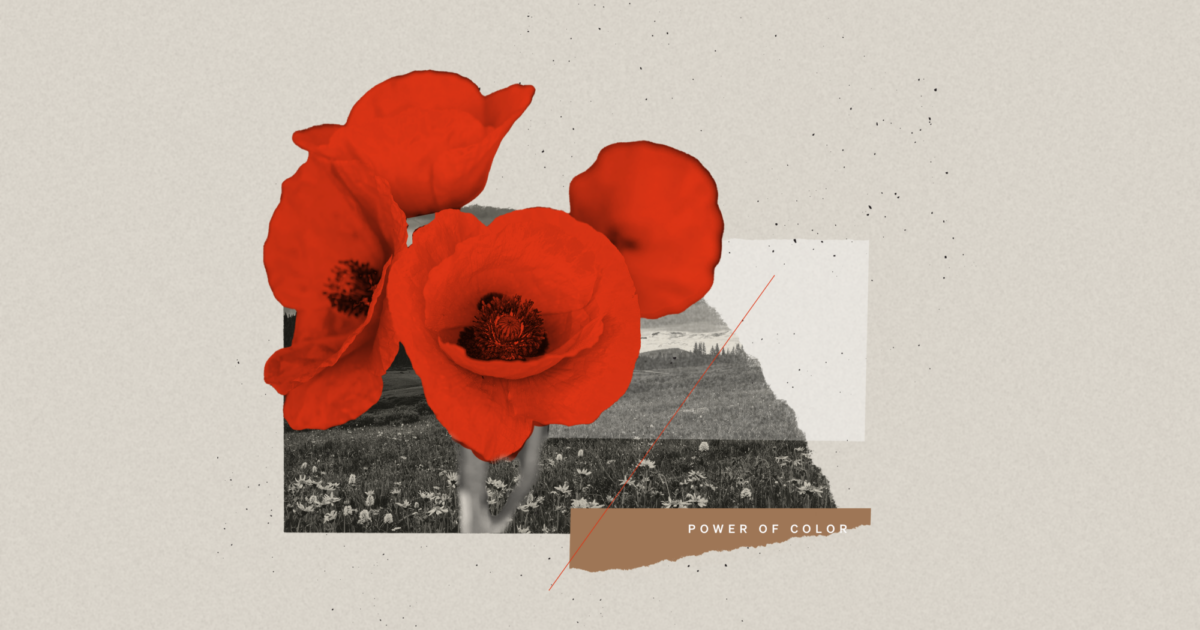Color infuses depth and life. It can support the larger brand story, unite the visual identity, and deliver a mood per millisecond in a way that sometimes only color can do.
An audio version of this article is available on our podcast, Focus on Brand.
Not long into The Wizard of Oz, Dorothy leaves a world of black and white and experiences Oz for the very first time in color. Eighty-two years later, it’s still an iconic cinematic breakthrough that demonstrates the power of color.
Stories are exponentially richer with color, and often so is our emotional connection to them. In a world without color, ruby red slippers and yellow brick roads don’t exist. The power of color applies to brands too. Their colors have the power to imprint on our minds and transport our imaginations from bland Kansas to fantastical Oz.
{{divider}}
Paint a larger brand story.
Every brand in the world has a mood and emotion it’s trying to express. The question becomes how to effectively communicate those. Often, words can do the heavy lifting, but color should never be overlooked in this area. Brands are a sum of parts, and color can be a valuable thread connecting them all. Color infuses depth and life. It can support the larger brand story, unite the visual identity, and deliver a mood per millisecond in a way that sometimes only color can do. A brand’s success is largely determined by its effectiveness in telling a cohesive, compelling story. Color is instrumental in that role. Georgia O’Keeffe said it well: “I found I could say things with colors and shapes that I couldn’t say any other way.”
{{divider}}
Align color with brand purpose and attributes.
A brand’s colors should be chosen with precision. Never waste this powerful asset by choosing something that simply “feels good.” This common misstep leaves so much brand equity on the table, uncapitalized.
Finding alignment with a brand’s attributes is a critical starting point in selecting brand colors. If your brand’s desire is to express trust and dependability, then you could consider some shade of blue. IBM, Unilever, and Lowe’s have likely adopted blue for this reason. If you’re looking to pull on the energy and excitement of your brand DNA, then you might consider bold reds. Red is said to engage the nervous system and boost the amount of adrenaline circulating in the bloodstream; it’s also associated with action and energy. This makes it easy to understand why organizations such as Virgin Group, Target, Lego, and Coca-Cola would leverage red so prominently.
Now, imagine a green Coca-Cola can or a purple Target logo. You would perceive a significantly different emotion from them. That’s the power of color.
{{divider}}
Outright ownership is not the goal.
A common misconception about color is its ownability and how much that should weigh in your color selection process. Sometimes we hear, “We want to achieve the recognizability of Tiffany,” to which we reply, “That is the 1%, and it took over a hundred years of consistency and marketing.”
Being able to “own” a color can be a strong asset, but is that even possible? The short answer is that some brands have trademarked a color, but that doesn’t necessarily equal complete ownership. Nickelodeon probably couldn’t stop The Home Depot from using orange. Each company operates in a different industry, and using similar shades of the same color is highly unlikely to lead to customer confusion. Another reason is color depletion; there simply are not enough colors available for each company to own any single shade. There is nuance here, but with only around 1,867 solid Pantone colors available, this could never work.
So to be clear, picking a color you can own is not the goal. However, you absolutely want to do your best to capture something unique in your space, while making sure it matches your attributes and brand story.
{{divider}}
What if all the colors in my vertical are taken?
So what happens when you find the right color for your brand, only to realize it’s already taken in your competitive landscape? This is where iteration and color variation come into play. This is also where an understanding that brands are larger than any single element can help inform decision making. Facebook, LinkedIn, and Twitter are examples of this in the real world. Their brand colors are blue, and they’re all social media-based; yet they’re all able to grow market share, tell different stories, provide different unique selling propositions, and resonate with different audiences. If blue is indeed right for them, there is no need for any of them to shift to pink simply to look different. That would likely have larger negative implications than running the “risk” of looking the same in regard to color.
Ask yourself, “Does this color support and elevate our brand’s story?” If your answer is yes and you are different in shade and execution than others in your competitive landscape, then you are on the right track. Your brand’s ultimate uniqueness is captured in the entire brand ecosystem, not solely by color. I assure you that there are many thriving coffee brands leveraging some version of green, not just Starbucks.
{{divider}}
As your brand evolves, colors can too.
Coming back to Tiffany & Co., brands should and do evolve. In a shocking move, the new owner of the Tiffany brand, LVMH, introduced what is being called Tiffany Yellow. You would think a major brand that’s probably in the top 1% when it comes to color recognition would never consider giving that up. But, proving many of the points above, it’s not about ownership; it’s about telling the right story and leveraging color in a way to propel the brand. LVMH recognized that this move would raise some serious eyebrows while also teasing out a new Tiffany story, allowing the brand to “appeal to the younger clientele who view the brand as dusty and old-fashioned.”
This is a powerful reminder that there’s no magic formula when it comes to brand colors. Different organizations in different markets with different goals will leverage color in various ways. But, inarguably, the best brands all leverage color as a pivotal brand touchpoint.
Originally published on Fast Company on November 16, 2021.




